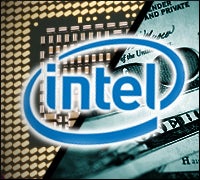 |
Intel will report its earnings after the close of market on Tuesday, April 14, and good news from the chip giant could cause a lot of people holding their breath to let out a huge sigh of relief. At least one analyst thinks we’re in for a pleasant surprise.
FBR Capital Markets has raised its target estimates for Intel’s (NASDAQ: INTC) first-quarter earnings, albeit slightly. The firm said its research found better-than-feared PC shipments in Q1, chip inventory levels now largely at “hand-to-mouth levels,” and promising activity in China, a major market.
But don’t break out the champagne yet. FBR projects Intel will post revenue of around $7.15 billion, better than the firm’s unofficial guidance of $7B. But that’s also 13 percent below Q4 2008 figures, although Q1 traditionally sees a fall-off from the fourth quarter’s Christmas rush.
FBR also raised its Q1 EPS estimate to $0.04, up from Wall Street’s estimates of $0.02, and thinks Q2 will see revenue in the $7.0 billion to $7.6 billion range. It raised its 2009 and 2010 EPS estimates to $0.50 and $0.80, respectively.
“While INTC may appreciate over the next year, we think investors may get a better entry point in the name this spring or summer. Furthermore, we prefer [Qualcomm] QCOM (mega-cap exposure) or [Marvell Communications] MRVL (PC sector play) as stocks that have better growth and valuation upside versus INTC,” the company wrote in a research note.
In checking with PC vendors, FBR found that evidence of a slight Intel revenue upside in Q1, while Q2 “suggests growth is likely.” The company found that component vendors aren’t shrinking as much as originally projected, hence the revision up in estimated revenue.
The firm said that in recent Q2 checks, its contacts expect notebook PC builds to grow about 10 percent to 12 percent sequentially, while desktop PC build production is likely to be flat to down a few points. That reflects the trend in notebook vs. desktop sales and given Intel’s dominance of the market, it should get most of that growth.
Two areas of actual demand are China, which has had its own government stimulus bill to give its economy a kick start, and PC sales are beginning to increase after stalling last year. FBR also said it noticed a “thawing” of corporate PC demand, which is very good news as most companies have all but stopped making capital expenditures for the past year.
FBR analyst Craig Berger, author of the report, appeared on CNBC’s “Fast Money” show on Monday to discuss his findings. Berger added that netbooks are a decent market opportunity for Intel but because the chips are cheaper, they represent fewer gross profit points.
He also said growth is slow in developed parts of the market, such as the U.S. and Europe. One of the things that may boost Intel’s numbers is inventory replenishment, and not necessarily “broad-based demand.”
Starting in Q4, many parts suppliers and OEMs halted their purchases of parts for fear of being stuck with excessive inventory. Many of them simply let their supply of inventory bleed out until it was almost all gone, and then replaced it only as needed or on a hand-to-mouth basis. That pattern is continuing, at least for now. Berger also added he didn’t know what demand would be like for the third and fourth quarters of the year.


